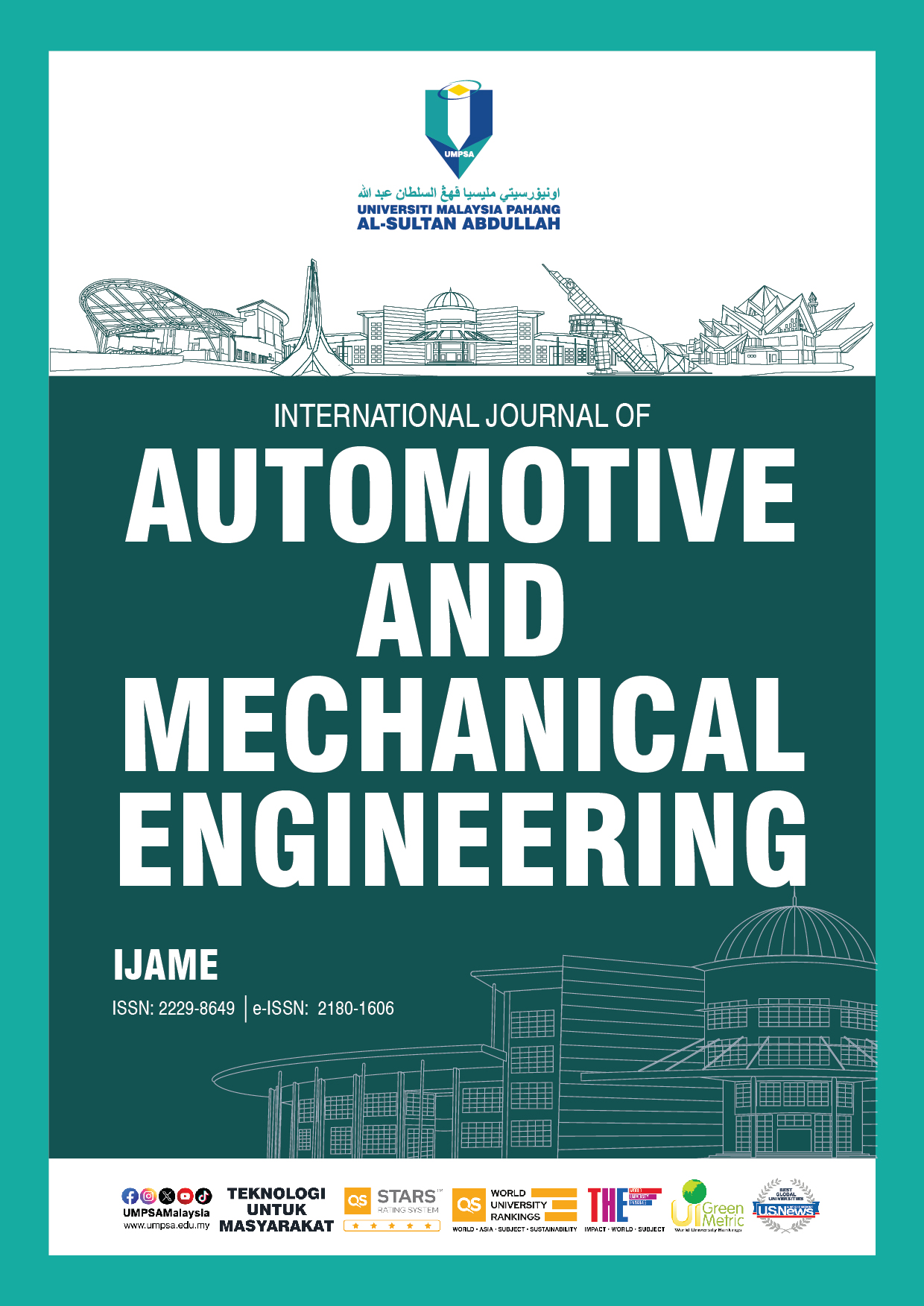Battery Electric Vehicle Lightweighting Strategies: Addressing Energy Consumption and Range Anxiety
DOI:
https://doi.org/10.15282/ijame.21.4.2024.4.0907Keywords:
Drive Cycle, Mass Composition, Road Condition, Energy Consumption, Weight ReductionAbstract
In general, an internal combustion engine vehicle is still the convention in personal and commercial transport, but due to its high use stage CO2 emission, a shift is occurring in propulsion methods, and the use of battery electric vehicles (BEV) will become the new norm. BEV’s curb weight is, in general, greater than that of a conventional fuelled vehicle (CFV) for equivalent classes. Consequently, it is questionable that the level of BEV’s energy consumption is acceptable. The aim of this paper is to compare the mass induced energy consumption of CFV and BEV. The expectation is that the comparative study of energy consumption between CFV and BEV will provide insight for proposing a strategy to determine the extent to which lightweighting can be introduced to a BEV. Encouragingly, less exhaustive energy consumption can help by reducing range anxiety by increasing BEV range, resolving one issue facing a BEV. With a typical road condition for hilly and flat roads, various drive cycles are also taken into consideration, and the energy consumption profiles for CFV and BEV can be determined. The vehicle model involved using the MATLAB/Simulink software underpinned by longitudinal vehicle dynamic methods. The idea is to determine the amount of lightweighting of various components of a BEV through an iterative process based on energy consumption profiles. As a function of mass reduction, for comparative energy expenditure, the results showed that a range of 28 to 36% reduction in BEV mass was achieved, which in turn can increase the driving range by 36.4 to 46.8%.
References
[1] M. Raugei, D. Morrey, A. Hutchinson, and P. Winfield, “A coherent life cycle assessment of a range of lightweighting strategies for compact vehicles,” Journal of Cleaner Production, vol. 108, pp. 1168–1176, 2015.
[2] K. Subramaniam and W. S.-I. Wan Salim, “Simulation of the performance of an electrically turbocharged engine over an urban driving cycle,” International Journal of Automotive and Mechanical Engineering, vol. 21, no. 1, pp. 11139–11154, 2024.
[3] P. Bera, “A design method of selecting gear ratios in manual transmissions of modern passenger cars,” Mechanism and Machine Theory, vol. 132, pp. 133–153, 2019.
[4] A.O. Kiyakli and H. Solmaz, “Modelling of an electric vehicle with MATLAB/Simulink,” International Journal of Automotive Science and Technology, vol. 2, no. 4, pp. 9–15, 2019.
[5] F. Del Pero, M. Delogu, and M. Pierini, “The effect of lightweighting in automotive LCA perspective: Estimation of mass-induced fuel consumption reduction for gasoline turbocharged vehicles,” Journal of Cleaner Production, vol. 154, pp. 566–577, 2017.
[6] C. Koffler and K. Rohde-Brandenburger, “On the calculation of fuel savings through lightweight design in automotive life cycle assessments,” International Journal of Life Cycle Assessment, vol. 15, no. 1, pp. 128–135, 2010.
[7] X. Ning, S. Zheng, Y. Wang, and J. Feng, “Lightweight design of gears in the wheel-side reducer based on Shanghai Road driving cycle,” Proceedings of the Institution of Mechanical Engineers, Part D: Journal of Automobile Engineering, vol. 233, no. 6, pp. 1586–1600, 2019.
[8] D. Pevec, J. Babic, A. Carvalho, Y. Ghiassi-Farrokhfal, W. Ketter, and V. Podobnik, “A survey-based assessment of how existing and potential electric vehicle owners perceive range anxiety,” Journal of Cleaner Production, vol. 276, p. 122779, 2020.
[9] R.L. Bartels, D. Kowalsky, T. Jonas, and G.A. Macht, “Ease of EVs: Exploring factors that influence battery consumption,” International Journal of Sustainable Transportation, vol. 14, no. 9, pp. 701–709, 2020.
[10] M. Janulin, O. Vrublevskyi, and A. Prokhorenko, “Energy minimization in city electric vehicle using optimized multi-speed transmission,” International Journal of Automotive and Mechanical Engineering, vol. 19, no. 2, pp. 9721–9733, 2022.
[11] J. Dixon, P.B. Andersen, K. Bell, and C. Træholt, “On the ease of being green: An investigation of the inconvenience of electric vehicle charging,” Applied Energy, vol. 258, p. 114090, 2020.
[12] J. Wang, I. Besselink, and H. Nijmeijer, “Battery electric vehicle energy consumption prediction for a trip based on route information,” Proceedings of the Institution of Mechanical Engineers, Part D: Journal of Automobile Engineering, vol. 232, no. 11, pp. 1528–1542, 2018.
[13] B. Nykvist, F. Sprei, and M. Nilsson, “Assessing the progress toward lower priced long range battery electric vehicles,” Energy Policy, vol. 124, pp. 144–155, 2019.
[14] L. Mao, A. Fotouhi, N. Shateri, and N. Ewin, “A multi-mode electric vehicle range estimator based on driving pattern recognition,” Proceedings of the Institution of Mechanical Engineers, Part C: Journal of Mechanical Engineering Science, vol. 236, no. 6, pp. 2677–2697, 2022.
[15] D. Pevec, J. Babic, A. Carvalho, Y. Ghiassi-Farrokhfal, W. Ketter, and V. Podobnik, “Electric vehicle range anxiety: An obstacle for the personal transportation (r)evolution?” in 2019 4th International Conference on Smart and Sustainable Technologies (SpliTech), Split, Croatia: IEEE, pp. 1–8, 2019.
[16] R. Alvarez, A. López, and N. De La Torre, “Evaluating the effect of a driver’s behaviour on the range of a battery electric vehicle,” Proceedings of the Institution of Mechanical Engineers, Part D: Journal of Automobile Engineering, vol. 229, no. 10, pp. 1379–1391, 2015.
[17] J. Hofer, E. Wilhelm, and W. Schenler, “Optimal lightweighting in battery electric vehicles,” World Electric Vehicle Journal, vol. 5, no. 3, pp. 751–762, 2012.
[18] F. Czerwinski, “Current trends in automotive lightweighting strategies and materials,” Materials, vol. 14, no. 21, p. 6631, 2021.
[19] P. Stabile, F. Ballo, G. Mastinu, and M. Gobbi, “An ultra-efficient lightweight electric vehicle - Power demand analysis to enable lightweight construction,” Energies, vol. 14, no. 3, p. 766, 2021.
[20] Y. He and H. Yi, “Developing active-spoiler on a new BEV using combined methods,” Journal of Physics: Conference Series, vol. 2820, no. 1, p. 012096, 2024.
[21] W. Zhou, C.J. Cleaver, C.F. Dunant, J.M. Allwood, and J. Lin, “Cost, range anxiety and future electricity supply: A review of how today”s technology trends may influence the future uptake of BEVs,” Renewable and Sustainable Energy Reviews, vol. 173, p. 113074, 2023.
[22] L. Nicoletti, A. Romano, A. König, P. Köhler, M. Heinrich, and M. Lienkamp, “An estimation of the lightweight potential of battery electric vehicles,” Energies, vol. 14, no. 15, p. 4655, 2021.
[23] W. Ji and G. Tal, “Scenarios for transitioning cars from ICEV to BEVs and PHEVs using household level GPS travel data,” Transportation Research Part D: Transport and Environment, vol. 88, p. 102555, 2020.
[24] F.D. Pero, M. Delogu, and M. Pierini, “Life Cycle Assessment in the automotive sector: a comparative case study of Internal Combustion Engine (ICE) and electric car,” Procedia Structural Integrity, vol. 12, pp. 521–537, 2018.
[25] A. Mayyas, M. Omar, M. Hayajneh, and A.R. Mayyas, “Vehicle’s lightweight design vs. electrification from life cycle assessment perspective,” Journal of Cleaner Production, vol. 167, pp. 687–701, 2017.
[26] J.T.J. Burd, E.A. Moore, H. Ezzat, R. Kirchain, and R. Roth, “Improvements in electric vehicle battery technology influence vehicle lightweighting and material substitution decisions,” Applied Energy, vol. 283, p. 116269, 2021.
[27] S. Ou, S. Zhang, Z. Lin, and S. Davis, “A method for determining optimal electric range by considering electric vehicle lightweighting on perceived ownership cost,” Journal of Cleaner Production, vol. 385, p. 135606, 2023.
[28] J. Hofer, E. Wilhelm, and W. Schenler, “Comparing the mass, energy, and cost effects of lightweighting in conventional and electric passenger vehicles,” Journal of Sustainable Development of Energy, Water and Environment Systems, vol. 2, no. 3, pp. 284–295, 2014.
[29] R.B. Carlson, H. Lohse-Busch, J. Diez, and J. Gibbs, “The measured impact of vehicle mass on road load forces and energy consumption for a BEV, HEV, and ICE vehicle,” SAE International Journal of Alternative Powertrains, vol. 2, no. 1, pp. 105–114, 2013.
[30] M. Redelbach, M. Klötzke, and H. E. Friedrich, “Impact of lightweight design on energy consumption and cost effectiveness of alternative powertrain concepts,” European electric Vehicle Conference, Brüssel, Belgien, 2012.
[31] F. Del Pero, L. Berzi, A. Antonacci, and M. Delogu, “Automotive lightweight design: Simulation modelling of mass-related consumption for electric vehicles,” Machines, vol. 8, no. 3, p. 51, 2020.
[32] Y.-A. Lin, P.-A. Chen, and K.-Y. Chan, “A method for reducing fuel consumption of urban scooters using vehicle design and traffic simulation,” Proceedings of the Institution of Mechanical Engineers, Part C: Journal of Mechanical Engineering Science, vol. 231, no. 7, pp. 1252–1271, 2017.
[33] E. B. Lárusdóttir and G. F. Ulfarsson, “Effect of driving behaviour and vehicle characteristics on energy consumption of road vehicles running on alternative energy sources,” International Journal of Sustainable Transportation, vol. 9, no. 8, pp. 592–601, 2015.
[34] G.M.H. Shahariar, T.A. Bodisco, A. Zare, M. Sajjad, M.I. Jahirul, T.C. Van et al., “Impact of driving style and traffic condition on emissions and fuel consumption during real-world transient operation,” Fuel, vol. 319, p. 123874, 2022.
[35] K. Liu, T. Yamamoto, and T. Morikawa, “Impact of road gradient on energy consumption of electric vehicles,” Transportation Research Part D: Transport and Environment, vol. 54, pp. 74–81, 2017.
[36] A. Loulizi, H. Rakha, and Y. Bichiou, “Quantifying grade effects on vehicle fuel consumption for use in sustainable highway design,” International Journal of Sustainable Transportation, vol. 12, no. 6, 2018.
[37] Y.-T. Zhang, C. G. Claudel, M.-B. Hu, Y.-H. Yu, and C.-L. Shi, “Develop of a fuel consumption model for hybrid vehicles,” Energy Conversion and Management, vol. 207, p. 112546, 2020.
[38] K. Boriboonsomsin and M. Barth, “Impacts of road grade on fuel consumption and carbon dioxide emissions evidenced by use of advanced navigation systems,” Transportation Research Record: Journal of the Transportation Research Board, vol. 2139, no. 1, pp. 21–30, 2009.
[39] S. Prakash and T.A. Bodisco, “An investigation into the effect of road gradient and driving style on NO X emissions from a diesel vehicle driven on urban roads,” Transportation Research Part D: Transport and Environment, vol. 72, pp. 220-231, 2019.
[40] N. Lutsey, “Review of technical literature and trends related to automobile mass-reduction technology,” Institute of Transportation Studies, UC Davis, Institute of Transportation Studies, Working Paper Series, 2010.
[41] C. Bauer, J. Hofer, H.-J. Althaus, A. Del Duce, and A. Simons, “The environmental performance of current and future passenger vehicles: Life cycle assessment based on a novel scenario analysis framework,” Applied Energy, vol. 157, pp. 871–883, 2015.
[42] J.C. González Palencia, T. Furubayashi, and T. Nakata, “Energy use and CO2 emissions reduction potential in passenger car fleet using zero emission vehicles and lightweight materials,” Energy, vol. 48, no. 1, pp. 548–565, 2012.
[43] G. Sandrini, M. Gadola, D. Chindamo, A. Candela, and P. Magri, “Exploring the impact of vehicle lightweighting in terms of energy consumption: analysis and simulation,” Energies, vol. 16, no. 13, p. 5157, 2023.
Downloads
Published
Issue
Section
License
Copyright (c) 2024 The Author(s)

This work is licensed under a Creative Commons Attribution-NonCommercial 4.0 International License.







